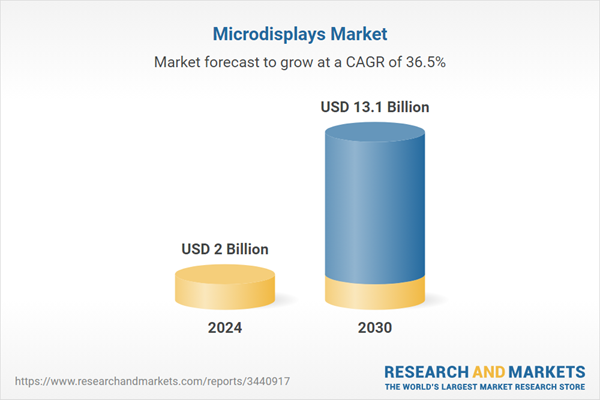The global market for Microdisplays was valued at US$2.0 Billion in 2024 and is projected to reach US$13.1 Billion by 2030, growing at a CAGR of 36.5% from 2024 to 2030. This comprehensive report provides an in-depth analysis of market trends, drivers, and forecasts, helping you make informed business decisions. The report includes the most recent global tariff developments and how they impact the Microdisplays market.
The advancement of microLED microdisplays is significantly reshaping the market, especially in augmented reality applications. MicroLED technology, known for its self-emissive properties and high efficiency, is increasingly integrated into AR glasses and head-mounted displays, enhancing visual fidelity and performance. The production of microLEDs involves sophisticated techniques that ensure high yields and operational reliability, highlighting the complexity of its manufacturing process which includes the growth of microLED material, pixel and subpixel formation, and the integration of microlens arrays and IC backplanes. These displays are not only pivotal for consumer technology but also hold the potential for broad applications across various sectors, driven by their ability to deliver high-quality visuals while maintaining energy efficiency and compactness.
Several key market forces are driving the growth of the microdisplay market. The demand for compact, energy-efficient devices with high-resolution displays is surging across consumer electronics, automotive applications, and medical devices. In automotive, for example, microdisplays are increasingly used in head-up displays (HUDs) to enhance safety and convenience by allowing drivers to view important information without looking away from the road. Similarly, in healthcare, microdisplays improve the precision and outcomes of medical procedures through their integration into devices like endoscopic systems and surgical microscopes. Additionally, the integration of artificial intelligence (AI) with microdisplay technologies is creating smarter, more interactive applications that can adapt to real-time conditions, particularly in automotive HUDs and AR systems. Advances in manufacturing technologies and the increasing demand for high-definition displays across all devices further fuel the expansion of the microdisplay market, emphasizing its integral role in the future of digital displays and interactive technologies.
Segments: Technology (LCD, LCoS, DLP, OLED); Application (Military & Defense, Consumer Electronics, Industrial, Automotive, Medical, Other Applications).
Geographic Regions/Countries: World; United States; Canada; Japan; China; Europe (France; Germany; Italy; United Kingdom; and Rest of Europe); Asia-Pacific; Rest of World.
The analysts continuously track trade developments worldwide, drawing insights from leading global economists and over 200 industry and policy institutions, including think tanks, trade organizations, and national economic advisory bodies. This intelligence is integrated into forecasting models to provide timely, data-driven analysis of emerging risks and opportunities.
Global Microdisplays Market - Key Trends and Drivers Summarized
Microdisplay technology is a pivotal force in the evolution of digital interactions, enriching a multitude of industries with enhanced visual capabilities in compact form factors. These high-resolution, diminutive displays are essential in augmented reality (AR), virtual reality (VR), and wearable devices, bridging the digital and physical realms effectively. Utilizing various technologies such as Liquid Crystal Displays (LCD), Organic Light Emitting Diodes (OLED), and Digital Light Processing (DLP), microdisplays offer superior image quality, with each technology catering to specific needs - LCDs are chosen for their color accuracy and efficiency, OLEDs for their high contrast and vibrant colors, and DLPs for their brightness and color fidelity. These technologies allow microdisplays to support a broad range of applications, from digital cameras and camcorders to immersive head-mounted displays and other devices requiring compact, energy-efficient solutions with excellent display performance.The advancement of microLED microdisplays is significantly reshaping the market, especially in augmented reality applications. MicroLED technology, known for its self-emissive properties and high efficiency, is increasingly integrated into AR glasses and head-mounted displays, enhancing visual fidelity and performance. The production of microLEDs involves sophisticated techniques that ensure high yields and operational reliability, highlighting the complexity of its manufacturing process which includes the growth of microLED material, pixel and subpixel formation, and the integration of microlens arrays and IC backplanes. These displays are not only pivotal for consumer technology but also hold the potential for broad applications across various sectors, driven by their ability to deliver high-quality visuals while maintaining energy efficiency and compactness.
Several key market forces are driving the growth of the microdisplay market. The demand for compact, energy-efficient devices with high-resolution displays is surging across consumer electronics, automotive applications, and medical devices. In automotive, for example, microdisplays are increasingly used in head-up displays (HUDs) to enhance safety and convenience by allowing drivers to view important information without looking away from the road. Similarly, in healthcare, microdisplays improve the precision and outcomes of medical procedures through their integration into devices like endoscopic systems and surgical microscopes. Additionally, the integration of artificial intelligence (AI) with microdisplay technologies is creating smarter, more interactive applications that can adapt to real-time conditions, particularly in automotive HUDs and AR systems. Advances in manufacturing technologies and the increasing demand for high-definition displays across all devices further fuel the expansion of the microdisplay market, emphasizing its integral role in the future of digital displays and interactive technologies.
Report Scope
The report analyzes the Microdisplays market, presented in terms of units. The analysis covers the key segments and geographic regions outlined below.Segments: Technology (LCD, LCoS, DLP, OLED); Application (Military & Defense, Consumer Electronics, Industrial, Automotive, Medical, Other Applications).
Geographic Regions/Countries: World; United States; Canada; Japan; China; Europe (France; Germany; Italy; United Kingdom; and Rest of Europe); Asia-Pacific; Rest of World.
Key Insights:
- Market Growth: Understand the significant growth trajectory of the LCD segment, which is expected to reach US$6.0 Billion by 2030 with a CAGR of a 33.3%. The LCoS segment is also set to grow at 39.7% CAGR over the analysis period.
- Regional Analysis: Gain insights into the U.S. market, valued at $564.8 Million in 2024, and China, forecasted to grow at an impressive 34.7% CAGR to reach $1.9 Billion by 2030. Discover growth trends in other key regions, including Japan, Canada, Germany, and the Asia-Pacific.
Why You Should Buy This Report:
- Detailed Market Analysis: Access a thorough analysis of the Global Microdisplays Market, covering all major geographic regions and market segments.
- Competitive Insights: Get an overview of the competitive landscape, including the market presence of major players across different geographies.
- Future Trends and Drivers: Understand the key trends and drivers shaping the future of the Global Microdisplays Market.
- Actionable Insights: Benefit from actionable insights that can help you identify new revenue opportunities and make strategic business decisions.
Key Questions Answered:
- How is the Global Microdisplays Market expected to evolve by 2030?
- What are the main drivers and restraints affecting the market?
- Which market segments will grow the most over the forecast period?
- How will market shares for different regions and segments change by 2030?
- Who are the leading players in the market, and what are their prospects?
Report Features:
- Comprehensive Market Data: Independent analysis of annual sales and market forecasts in US$ Million from 2024 to 2030.
- In-Depth Regional Analysis: Detailed insights into key markets, including the U.S., China, Japan, Canada, Europe, Asia-Pacific, Latin America, Middle East, and Africa.
- Company Profiles: Coverage of players such as eMagin Corporation, Himax Technologies, Inc., Jasper Display Corp., Kopin Corporation, LG Display Co., Ltd. and more.
- Complimentary Updates: Receive free report updates for one year to keep you informed of the latest market developments.
Some of the 19 companies featured in this Microdisplays market report include:
- eMagin Corporation
- Himax Technologies, Inc.
- Jasper Display Corp.
- Kopin Corporation
- LG Display Co., Ltd.
- Micron Technology, Inc.
- Microtips Technology
- Seiko Epson Corporation
- Sony Semiconductor Solution Corporation
- Universal Display Corporation
- Wisechip Semiconductor, Inc.
- Yunnan OLiGHTEK Opto-Electronic Technology Co., Ltd.
Tariff Impact Analysis: Key Insights for 2025
Global tariff negotiations across 180+ countries are reshaping supply chains, costs, and competitiveness. This report reflects the latest developments as of April 2025 and incorporates forward-looking insights into the market outlook.The analysts continuously track trade developments worldwide, drawing insights from leading global economists and over 200 industry and policy institutions, including think tanks, trade organizations, and national economic advisory bodies. This intelligence is integrated into forecasting models to provide timely, data-driven analysis of emerging risks and opportunities.
What’s Included in This Edition:
- Tariff-adjusted market forecasts by region and segment
- Analysis of cost and supply chain implications by sourcing and trade exposure
- Strategic insights into geographic shifts
Buyers receive a free July 2025 update with:
- Finalized tariff impacts and new trade agreement effects
- Updated projections reflecting global sourcing and cost shifts
- Expanded country-specific coverage across the industry
Table of Contents
I. METHODOLOGYII. EXECUTIVE SUMMARY2. FOCUS ON SELECT PLAYERSIII. MARKET ANALYSISIV. COMPETITION
1. MARKET OVERVIEW
3. MARKET TRENDS & DRIVERS
4. GLOBAL MARKET PERSPECTIVE
UNITED STATES
CANADA
JAPAN
CHINA
EUROPE
FRANCE
GERMANY
ITALY
UNITED KINGDOM
REST OF EUROPE
ASIA-PACIFIC
REST OF WORLD
Companies Mentioned (Partial List)
A selection of companies mentioned in this report includes, but is not limited to:
- eMagin Corporation
- Himax Technologies, Inc.
- Jasper Display Corp.
- Kopin Corporation
- LG Display Co., Ltd.
- Micron Technology, Inc.
- Microtips Technology
- Seiko Epson Corporation
- Sony Semiconductor Solution Corporation
- Universal Display Corporation
- Wisechip Semiconductor, Inc.
- Yunnan OLiGHTEK Opto-Electronic Technology Co., Ltd.
Table Information
| Report Attribute | Details |
|---|---|
| No. of Pages | 198 |
| Published | April 2025 |
| Forecast Period | 2024 - 2030 |
| Estimated Market Value ( USD | $ 2 Billion |
| Forecasted Market Value ( USD | $ 13.1 Billion |
| Compound Annual Growth Rate | 36.5% |
| Regions Covered | Global |









